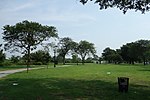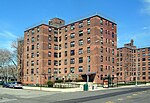Beach 60th Street station
1956 establishments in New York CityIND Rockaway Line stationsNew York City Subway stations in Queens, New YorkNew York City Subway stations located abovegroundRailway stations in the United States opened in 1956 ... and 1 more
Rockaway, Queens

The Beach 60th Street station (signed as Beach 60th Street–Straiton Avenue station) is a station on the IND Rockaway Line of the New York City Subway. Located in Queens on the Rockaway Freeway at Beach 60th Street, it is served by the A train at all times.
Excerpt from the Wikipedia article Beach 60th Street station (License: CC BY-SA 3.0, Authors, Images).Beach 60th Street station
Rockaway Freeway, New York Queens County
Geographical coordinates (GPS) Address Nearby Places Show on map
Geographical coordinates (GPS)
| Latitude | Longitude |
|---|---|
| N 40.592395 ° | E -73.788536 ° |
Address
Beach 60th Street
Rockaway Freeway
11692 New York, Queens County
New York, United States
Open on Google Maps










